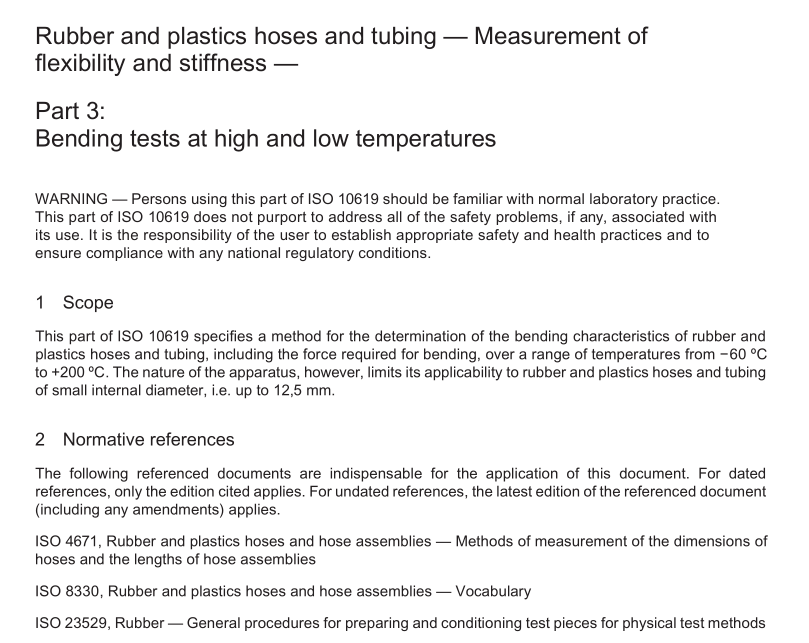BS ISO 10619-3 pdf download

BS ISO 10619-3 pdf download Rubber and plastics hoses and tubing — Measurement of flexibility and stiffness Part 3: Bending tests at high and low temperatures
4Method
4.1Apparatus
4.1.1 Compression testing machine, with a rate of travel of the moving jaw of 100 mm/min,preferablyprovided with a chart recorder. A scale, graduated in millimetre divisions,may be attached to the moving jawto enable the bend diameter to be measured or, preferably, this may be determined from a graphical record orother measuring device.
4.1.2 Pair of twin channel-shaped holders, fitted with end stops for the hose test pieces (see Figure 1).
4.1.3 Thermostatically controlled environmental chamber, which can be fitted to the testing machine with theprovision for access to enable the external diameter of the hose to be measured.
4.2Hose test pieces
4.2.1 Types and dimensions
The test shall be carried out on two hose pieces (one set), of equal length, of the hose or tubing under test.The length of the hose test pieces depends on the dimensions of the hose test piece holders and shall be2G+0,5 Ti(C+D), where G is the length of the hose test piece holders (see Figure 1) and C is twice the minimumbend radius specified in the appropriate specification. Iin no case shall the hose test pieces come into contactwith the walls of the chamber and the length,L,shall always be less than the length of the enclosure.
4.2.2 Number of hose test pieces
Unless otherwise specified, three sets of tests shall be carried out (one set being two hose test pieces).
4.3Conditioning of hose test pieces
No test shall be carried out within 24 h of manufacture.
For evaluations which are intended to be comparable, the test shall, as far as possible, be carried out after thesame time interval after manufacture. The time between sample manufacture and testing shall be in conformitywith ISO 23529.
Before testing, the hose test pieces shall be conditioned in the straight condition or conforming to their naturalcurvature for 5 h in the environmental chamber (4.1.3) at the specified temperature (see 4.4).
44Test temperature
The test temperature is specified in the appropriate hose specification.
4.5Test procedure
4.5.1 Where testing is being done on samples conditioned to sub-ambient temperatures, the following testshould be completed within 8 s to 12 s. Testing on samples conditioned at higher temperatures should becompleted within 5 s and the test equipment should be conditioned to the same temperature as the test piec.
4.5.2 Measure the outside diameter,D, three times at the midpoint of the test pieces in the unstressedcondition by means of a suitable measuring instrument as specified in lSO 4671.A total of three readings perset for each test piece shall be taken and the average of these should be used for the value of D;.
4.5.3Install the test piece between the holders with a large bend radius and the ends of the test piecesagainst the end stops.The curvature shall follow the natural curvature, if any.
4.5.4 Start the machine.Apply force between A and B(Figure 1) and determine the force required to reachtwice the specified bend radius.
4.5.5 Divide the force value obtained by direct reading or from a graphical record by two to obtain the bendingforce for a single test piece.
4.5.6 Measure the outside dimension, T (see Figure 1) at the smallest diameter in the curved part of the hose.Six readings should be taken and the average of these should be used for the value of Ti.
5Expression of results
Calculate the value Ti/Dj using the mean values obtained.
Where Tis the outside diameter measured (see Figure 1) when the hose sample has been bent to its minimumbend radius and Djis the outside diameter of the hose measured at the midpoint of the sample in the unstressedstate.
Compare the result with the permitted deformation given in the appropriate hose specification.
6 Test report
The test report shall include the following information:
a)a reference to this part of lSO 10619,i.e.lSO 10619-3:2011;b)details of the method used;
)a full description of the hose or tubing tested and a reference to the hose specification in accordance with
which the hose was tested;
d)the test temperature;
e)observation on any abrupt change(s) in hose section or irregularity in curvature caused by kinking;f)the value of Di,Tiand T;/Di;
g)whether or not T/D; was within the permitted deformation;
h)the force required to reach the specified bend radius, if appropriate;i)the date of the test.









